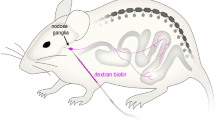Abstract
THE compound 6-hydroxydopamine (2,4,5-trihydroxyphenylethylamine) produces a long lasting depletion of noradrenaline (NA) from peripheral sympathetically innervated tissues in various species1,2. It was originally suggested that the depletion of noradrenaline produced by 6-hydroxydopamine might be a result of damage to the amine storage sites in sympathetic nerves in a manner similar to that of reserpine, or that, alternatively, 6-hydroxydopamine might act as a “false transmitter” and displace noradrenaline from sympathetic nerves1–4. Electron microscopy has shown recently, however, that after treatment with 6-hydroxydopamine the terminal regions of peripheral adrenergic nerves degenerate and eventually disappear5. The noradrenaline depletion produced by 6-hydroxydopamine has been suggested to result from this acute degeneration of adrenergic terminals. This hypothesis was supported by the histochemical evidence that after treatment with 6-hydroxydopamine the fluorescent network of sympathetic nerve terminals in the rat iris disappeared, while the fluorescence of preterminal axons increased6. 6-Hydroxydopamine thus induces changes similar to those seen after section of an adrenergic nerve, suggesting that this compound produces a “chemical sympathectomy”5.
Similar content being viewed by others
References
Porter, C. C., Totaro, J. A., and Stone, C. A., J. Pharm. Exp. Ther., 140, 308 (1963).
Laverty, R., Sharman, D. F., and Vogt, M., Brit. J. Pharmacol. Chemother., 24, 549 (1965).
Porter, C. C., Totaro, J. A., and Burcin, A., J. Pharm. Exp. Ther., 150, 17 (1965).
Stone, C. A., Porter, C. C., Stavroski, J. M., Ludden, C. T., and Totaro, J. A., J. Pharm. Exp. Ther., 144, 196 (1964).
Thoenen, H., and Tranzer, J. P., Arch. Pharmak. u. Exp. Path., 261, 271 (1968).
Malmfors, T., and Sachs, Ch., Europ. J. Pharmacol., 3, 89 (1968).
Noble, E. P., Wurtman, R. J., and Axelrod, J., Life Sci., 6, 281 (1967).
Merlis, J. K., Amer. J. Physiol., 131, 67 (1940).
Iversen, L. L., Brit. J. Pharmacol. Chemother., 21, 523 (1963).
Euler, U. S. von, and Lishajko, F., Acta Physiol. Scand., 51, 348 (1961).
Iversen, L. L., The Uptake and Storage of Noradrenaline in Sympathetic Nerves (Cambridge University Press, London, 1967).
Hamberger, B., and Masuoka, D., Acta Pharm. Toxicol., 22, 363 (1965).
Snyder, S. H., Green, A. I., and Hendley, E. D., J. Pharm. Exp. Ther., 164, 90 (1968).
Hamberger, B., Acta Physiol., Scand., 71, Suppl. 295 (1967).
Glowinski, J., and Iversen, L. L., J. Neurochem., 13, 655 (1966).
Glowinski, J., Iversen, L. L., and Axelrod, J., J. Pharm. Exp. Ther., 151, 385 (1966).
Iversen, L. L., and Neal, M. J., J. Neurochem., 15, 1141 (1968).
Author information
Authors and Affiliations
Rights and permissions
About this article
Cite this article
URETSKY, N., IVERSEN, L. Effects of 6-Hydroxydopamine on Noradrenaline-containing Neurones in the Rat Brain. Nature 221, 557–559 (1969). https://doi.org/10.1038/221557a0
Received:
Issue Date:
DOI: https://doi.org/10.1038/221557a0
- Springer Nature Limited
This article is cited by
-
Cellular pathology of Parkinson?s disease: astrocytes, microglia and inflammation
Cell and Tissue Research (2004)
-
Variability among brain regions in the specificity of 6-hydroxydopamine (6-OHDA)-induced lesions
Journal of Neural Transmission (1989)





